#fauna guide
Explore tagged Tumblr posts
Text
Clanmew Expansion Pack: Moths and Butterflies
A guide to the beautiful fluttering insects seen in this region, and how Clan cats classify and describe them.
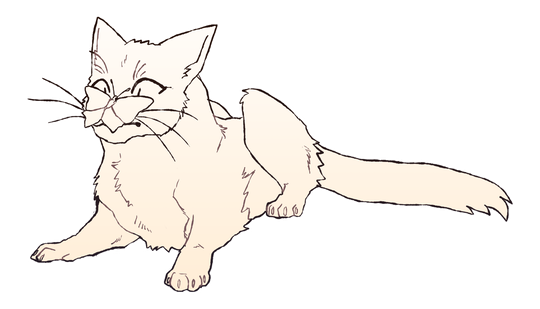
[ID: A cat with a butterfly on its nose]
In Clanmew, the vocabulary used to describe butterflies is massive compared to English. As a species less than a foot tall and spending their entire lives in the wilderness, Clan cats observe lepidopterians up close and far more personally than humans have done historically.
Combine this with the fact that cats are crepuscular, active in the morning and evening, and you'll realize that they encounter more moths than butterflies. While English-speaking humans tend to think of moths as being dingy and butterflies as being colorful, Clan cats don't find those categories helpful and classify them in a completely different way!
So the very first thing to know is that Clanmew does not have the same conception of "moths" and "butterflies." They have a super term, "Ffyy," and no less than 9 terms for the various groups with related behaviors.
This guide contains 51 new words for various moths and the unique behaviors of lepidopterians. Below the cut, you will find;
An overview to the 9 classifications Clan cats use, plus words for things like cocoons, metamorphosis, caterpillars, etc
A straightforward list of species, in English (Science) = Clanmew format
Expansion on behaviors of noteworthy species within their groupings
Translation trivia on Moth Flight, Mothwing, Archeye, and Mothwhisker (TC) for Better Bones.
(Translator's Note: I have tried to pick English words that will work nicely as warrior name prefixes, to be translated as specifically or as generically as you desire. They don't reflect cladistic accuracy.)

Types of Ffyy:
Flutter = Kffa Ffyy with large hindwings that flutter around erratically. The closest to the English image of a "butterfly." Most of these are daytime species but this also refers to moths that are drawn to flame. Species depicted: Speckled wood (Pararge aegeria)
Hawkmoth = Uff Fat-bodied ffyy that tend to be wider than they are long, with powerful wings. Fantastic fliers and important pollinators, they have several gigantic species and are beloved by Clan cats. Species depicted: Elephant hawkmoth (Deilephila elpenor)
Tortrix = Owyy Round-winged ffyy that rest with a slightly splayed pose with their wings folded down, almost resembling a turtle. Species depicted: Privet tortrix (Clepsis consimilana)
Veneer = Iff A thin, lanky ffyy that rests in a sticklike pose with a defined head, sporting big, buggy eyes and sometimes a large nose. Any moth with the characteristic eyes or nose gets brought back into this category. Species depicted: Garden-grass veneer (Chrysoteuchia culmella)
Herald = Hawof A very unique type, it can apply to just about any type of moth but is always given to the species with significance in prophetic divination. There are some moths rarely seen in this region which appear only as heralds, thus they are named accordingly. NOTE: This is the sort of word bestowed in Honor Titles. Species depicted: Common Hairstreak, Moth Flight's moth (Callophrys rubi)
Dowd = Gyyff Stiff, fluffy moths which rest as straight as a twig, usually mimicking wood. Their heads aren't as well defined as a veneer, but they aren't as fluffy as a raoff Species depicted: Buff-tip (Phalera bucephala)
Prominent = Raoff "Lion moths," large species with fluffy antennae and big manes. Something between a dowd and a tortrix, but usually larger and fluffier. Species depicted: Muslin moth (Diaphora mendica)
Plume = Ffip Very thin, slender moths that rest in a T-pose with very interesting wing-types. Species depicted: Beautiful plume moth (Amblyptilia acanthadactyla)
Fritilary = Ffow Somewhat between a Kffa and an Owyy, refers to Ffyy with a smoother 'cape' shape when they're resting.
In addition, there are words for shapes associated with Ffyy and other insects, especially in the wings and patterns. Some of those words are;
Fluttered/Fluttering/Will flutter = Afafaf/Afafa/Afaf The erratic wingbeats of Ffyy and small birds of prey.
Hovered/hovering/will hover = Hyyffuhu/hyyffu/hyyff A very special aerial maneuver where an animal can hold their exact place in the air and move in any direction. EXTREMELY rare; only achieved by certain hawkmoths, hoverflies, and dragonflies. NOTE: The UK has no hummingbirds! Their ecological niche is occupied by hawkmoths!
Shy = Wro An emotion, but also a pose. It's when an animal shrinks back and tries to make itself smaller or more hidden, much like a Dowd or a Veneer, or the flattening of a terrified cat's ears
Cape/Humble = Froom An emotion, a shape, and a pattern that is seen on the backs of some animals, describes the way that Prominents and Tortrixes hold their wings.
Flare/Confident/Perpendicular = Akeye An emotion and a shape, describes things that 'stick up,' like the wings of Plumes and Butters. Not like "raised hackles," more like fluffing one's fur out or puffing your chest.
Caterpillar = Poog A word that comes from Parkmew! Caterpillars were significant to Park cat culture because of their old naming system-- cats were born unnamed, and were expected to find one as they grew, like butterflies.
Pupa/Chrysalis = Higab Hard, scaly insect cocoons
Cocoon = Mooun Soft, silky insect cocoons
Silk = Mirro The material that silk cocoons and spider webs are made of. Only cob spiders produce though of this material to be useful to Clan cats; they do not have access to silk moths (bombyx mori) in this part of England. Clan cats also believe that moth wings are made of this.
Chitin = Higko The material that hard pupa and insect exoskeletons are made of.
Exoskeleton = Babaak The hard shell that surrounds the meat of invertebrates such as crabs, moths, beetles; Clan cats do not think this applies to insects that 'shrivel' such as soft-bodied caterpillars.
Metamorphosed/metamorphing/will metamorph = Peb'bep'arr/Peb'bep/Peb'be To massively change between stages of life, the unique way that moths and some other insects grow.
LIST OF SPECIES
This list is arranged with several species of each group, separated by grouping. You can expect for this list to grow, if additional species are translated as time goes on!
Last update: 6/17/2023
HAWMOTH/UFF
Elephant hawkmoth (Deilephila elpenor) = Beksu
Large skipper (Ochlodes sylvanus) = Skepb
Hummingbird hawkmoth (Macroglossum stellatarum) = Lipfu
TORTRIX/OWYY
Privet tortrix (Clepsis consimilana) = Frooke
Oak lantern (Carcina quercana) = Byoff
Common footman (Eilema lurideola) = Yyowo
Dark Arches (Apamea monoglypha) = Oyiw
VENEER/IFF
Garden-grass veneer (Chrysoteuchia culmella) = Chuo
Drinker moth (Euthrix potatoria) = Ssbwohl
Bronze alder moth (Argyresthia goedartella) = Holipo
DOWD/GYYFF
Buff-tip (Argyresthia goedartella) = Kooko
Apple leafminer (Lyonetia clerkella) = Rugna
Hazel slender (Parornix devoniella) = Geehees
PROMINENT/RAOFF
Muslin (Diaphora mendica) = Goorf
Iron prominent (Notodonta dromedarius) = Orge
True lover's knot (Lycophotia porphyrea) = Urmrri
Cinnabar (Tyria jacobaeae) = Genra
PLUME/FFIP
Beautiful plume (Amblyptilia acanthadactyla) = Lebl
Twenty plume (Alucita hexadactyla) = Arrffip
FLUTTER/KFFA
Speckled wood (Pararge aegeria) = Yaero
Holly blue (Celastrina argiolus) = Luya
Clouded border (Lomaspilis marginata) = Oogwo
FRITILARY/FFOW
Magpie moth (Abraxas grossulariata) = Peewo
Mint moth (Pyrausta aurata) = Mwifg
Riband wave (Idaea aversata) = Fisip
HERALD/HAWOF
Green Hairstreak (Callophrys rubi) = Ssefyy
Lunar Hornet (Sesia bembeciformis) = Offes
Death's Head (Acherontia atropos) = Wayoff
HAWKMOTH/UFF

[ID: An "Uff," 'Hawkmoth' in English. It is a large, yellow-and-pink moth. The species depicted is an Elephant Hawkmoth.]
Hawkmoths are the largest types of Ffyy that Clan cats encounter, and deeply beloved. They are considered the 'warriors' of moth-standards, large, honorable, and acrobatic. What defines an uff from other butterflies is primarily its large, bulky body. Some uff, such as the skipper, could be mistaken by outsiders as being a type of ffow or perhaps a kffa.
They are pollinators, jumping between various flowers and mostly seen in grassy, floral environments, such as meadows and moorland. The skipper in particular is one of WindClan's most common butterflies, and a favorite target for pouncing kittens.
Most of the largest hawkmoths survive the winter snug in their cocoons under leaf litter, and more specifically in ThunderClan. Being able to witness a hawkmoth emerge is sometimes taken as a little blessing, like StarClan rewarding you for staying observant on a patrol.
TORTRIX/OWYY
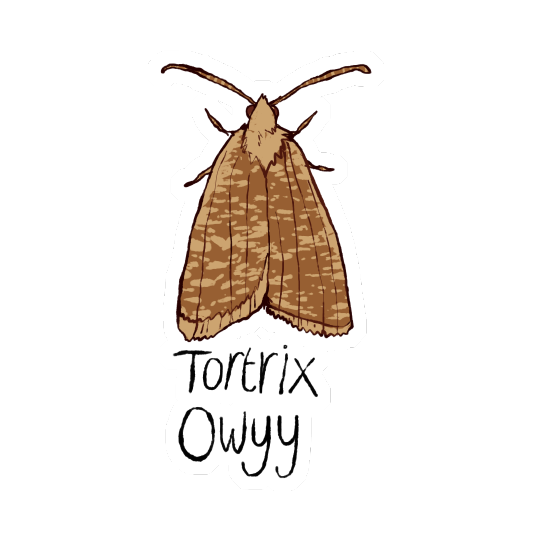
[ID: An Owyy, "Tortrix" in English. It is a humble brown moth with a negligible mane and round, capelike wings. The species depicted is a privet tortrix.]
Tortrixes are the largest classification of ffyy in Clanmew, with many of them being drawn to lights in the dark. They hold their wings 'humbly' (froom), tucked behind themselves and slightly angled. Many prominent share the general shape of tortrixes, but they are separated by a prominent, impressive mane.
Because they are so varied, classifying behaviors of the group as a whole is difficult. Some of them like fruit and others like leaves. Some are large and others small. Some are drab and others colorful.
Most end up named after the species of plant they like most. The Oak Lantern (Byoff) for example can skeletonize entire oak leaves! Others can absolutely mob apple trees, making them a pest to ThunderClan.
Funfact: The cartoon idea of an "apple worm" comes from some species of tortrix moths!
FLUTTER/KFFA
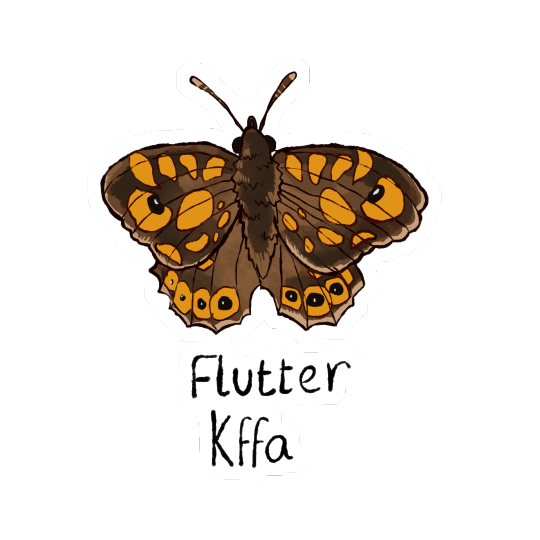
[ID: A Kffa, "Flutter" in English. It is an orange-and-brown butterfly, with wings that stick out perpendicular to the body. The species depicted is a sunspot butterfly.]
Dominated by strange daytime species with bright colors, these confident little creatures are defined by the angle of their wings when resting. They "Flare" out, or Akeye in Clanmew.
The Yaero (sunspot butterfly/speckled wood) is the most well-known of the flutters which isn't also a herald of some sort. These plucky bugs have short lives and spend the ENTIRE time fighting, choosing a sunny spot and engaging in clumsy aerial brawls to defend it. To be compared to a Yaero in Clan Culture is like being called 'scrappy,' fighting until you drop dead of exhaustion.
It's a VERY admirable thing to be!
PROMINENT/RAOFF

[ID: A "Raoff," or a Prominent in English. It is a very fluffy moth with a big mane. The species depicted is a male muslin moth.]
The obvious thing that sets this sort of Ffyy apart from all others is its luscious, majestic mane. Much like how the "Leopard" is a mistranslation and is a mythical composite of several animals, the Clan cat "Lion" is a composite beast whose mane comes from moths!
Thus, it is how they were named. Lion + Moth.
And, of the various raoff, the muslin (Goorf) is one of the most interesting. It comes in black or white, with many cats speaking of a herald coloration that is split perfectly down the middle with black and white. This species' name comes from "Gender + Moth." It is thought that if a pregnant cat only sees black muslins, they will have an all-tom litter. All white, and they will all be mollies. If no muslin moths are seen at all, then they will all reveal themselves to be gib.
FRITILARY/FFOW
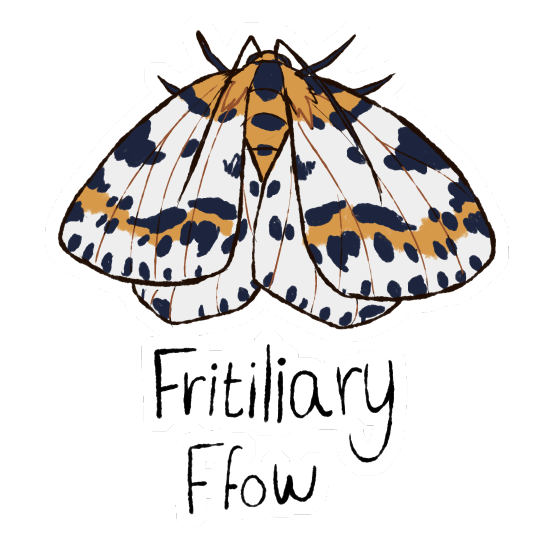
[ID: A "ffow," or a fritilary in English. Note, this is the moment where the English names diverge the most because this is not an irl fritilary. It is a moth with a 'cape' that is both froom, and akeye. The species depicted is a magpie moth.]
A family of ffyy remarked upon for their 'savviness.' Not as 'confident' as kffa, nor as humble as an owyy, the animals in this family are typically quite interesting.
For example, the magpie (Peewo). While notably beautiful like a calico cat, it's also strangely left alone by other animals. If caught in a spiderweb, the spider will take a bite and let go. Birds leave them alone. Clan cats believe this must be because they will eat lots of unappetizing plants and become distasteful-- a clever creature!
The thought probably came from watching another ffow, the Mwifg, the "mint moth" in English. Mint is a deadly poison to Clan cats, but the creature eats it up, and goes unbothered by other animals.
So, Peewo and Mwifg are cited often as living examples of how you, "are what you eat."
PLUME/FFIP
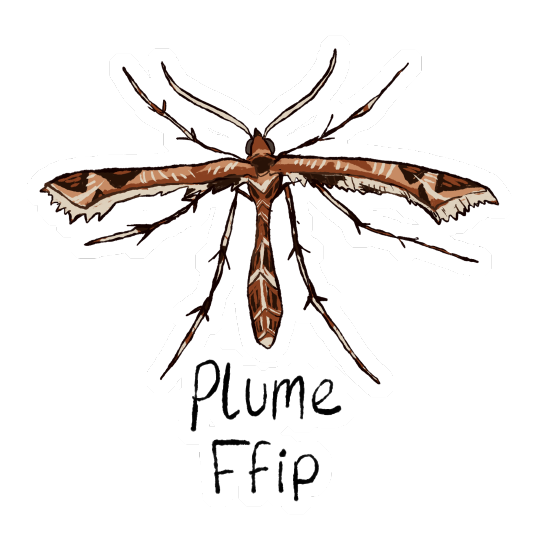
[ID: A plume moth, "ffip," a thin insect with a T-shaped body and long legs. The species depicted is a Beautiful Plume Moth.]
Widely considered the least appealing type of moth, often clustered in reedy areas. They're known by their distinctive T-shape and long legs.
Clan Cats find it unsettling that they resemble midges, and have only two unique names within the classification; Arrffip for the 20-Plume, and Lebl for the Beautiful Plume, which resembles a mottled cat which makes it more okay to them.
VENEER/IFF

[ID: A moth with big eyes and a long nose, called an "Iff" in Clanmew, and a veneer in English. The species depicted is a garden grass veneer.]
The silliest moth of all, associated with being panicked and anxious at all times. To be compared to an Iff is to be called a worry-wart in Clanmew!
Most veneers have a big, distinct fuzzy nose, and any moth that displays the same feature gets thrown into the Iff classification. But that isn't the only way to end up in this category! Any moth with big, worried eyes goes here as well, such as the Bronze Alder Moth (Holipo).
Alderheart was compared to a holipo often. Poor guy.
There is also the drinker moth (Ssbwohl), which is known for dunking its head into dewdrops and taking a big sippy.
DOWD/GYYFF

[ID: A moth that looks like a twig, called a Dowd in English and a Gyyff in Clanmew. The species depicted is a buff-tip.]
To be considered a Gyyff, the moth must be long and sticklike. The apple leafminer (Rugna) is a good example of a moth that is not using buff-tip (Kooko) mimicry, but is still a Dowd in Clanmew standards.
The word "kooko" in Clanmew is used for harmless fibs, little pranks, and the buff-tip moth!
HERALD/HAWOF
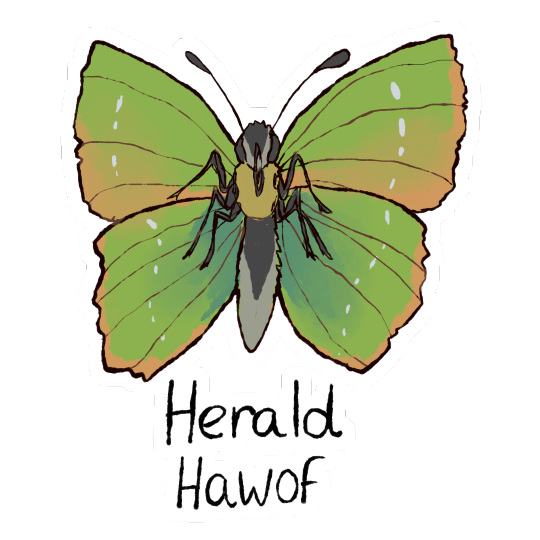
[ID: A green butterfly with shining wings, facing the camera. It is called a Herald in English, and a Hawof in Clanmew. The species depicted is a Green Hairstreak.]
The defining example of the Herald classification is the Green Hairstreak, an iridescent green moth that lead Moth Flight to the Moonstone so many years ago. A vitally important species to WindClan culturally, a burst in its population is said to be a sign that they need to listen carefully.
Any type of moth can end up going into this category, if it becomes significant in divination. Some moths have even shifted over time out of one classification into Hawof, and back out as they stop being seen as holy in some way!
Another example of a moth of great significance is the death's head moth, called a Wayoff in Clanmew. It's a massive type of hawkmoth, and an exceedingly rare sight. It warns of grand doom, threats so large that they threaten all the Clans at once. Floods, famine, deforestation... these were all preceded by the freak sighting of a Wayoff.
Meanwhile, the Lunar Hornet, Offes in Clanmew, mimics a wasp perfectly. It's a strange creature said to be a piece of the cosmic dust between this world and StarClan, an example of the fantastic creatures they can make if they so choose. It signifies change of some sort, which a Cleric will attempt to interpret for the cat who saw the moth.
And lastly,
Translation Trivia

[ID: A cat chasing a butterfly]
Specifically for the way I have chosen to translate the names of these characters for the Better Bones AU
Moth Flight
Mothwing
Archeye
Mothwhisker
Moth Flight Hawof Faofwe (Herald + Pilgrimage)
A VERY interesting translation quirk, as her name is a remnant from Old Tribemew, one of the ancestral languages that would eventually form Clanmew!
Hawof was the ancient word for moths and butterflies, and still the word in-use in Tribemew to this day. Once they moved down from the highlands, Clanmew adopted and created several new words to describe the hundreds of new types they were seeing on a regular basis. Yet, "hawof" fossilized, coming to only describe those that were particularly holy!
"Faofwe" is another fascinating example. While it once meant 'flight' in Old Tribemew, an animal flying from one place to another, it has come to mean "pilgrimage." This is the word being used for a cat going to visit a holy location, or somewhere else that they will reach a higher religious understanding of the world.
Both of these words are sacred; the type only given to modern cats in Honor Titles.
Mothwing Beksuwesk (Elephant Hawkmoth + Insect Wing)
Sasha fled the violence of TigerClan at her first opportunity, after being trapped in the dangerous situation with no escape. After the death of her son, Tadpole, she brought her kits to RiverClan in the hopes they would be safe. Their names were Ffyy, and Yassga.
Leopardstar saw that their father was Tigerstar, and accepted... though she would change their names. They had to accept what the Clan was to decide for them.
So Yassga (Raptor, any large bird of prey) became Yi'i (sparrowhawk), and Ffyy (Any butterfly) was pigeonholed into a type of hawkmoth as Besku. She thinks of this often, that RiverClan took the name her mother gave her, that she followed Hawkfrost to the Lake, and now she is all that remains. With nothing left of her family.
Archeye Oyiwipo (Dark Arches Moth + Eye)
A simple one! He has a stripe just above one eye that perfectly resembles the tip of a Dark Arches' wing.
(note: i updated this translation from an earlier statement.)
Mothwhisker Yaerohussk (Speckled Wood Butterfly + Hussk)
Fresh from the ThunderClan Family Tree fix, Mothwhisker is a parent of Adderfang and Seedfall.
An old Oakstar loyalist, Mothwhisker was spitting from the moment he was born, clawing the nose of his Ba. On the spot, he was given the prefix Yaero, and he eventually grew into a ferocious Crusader after the death of Mapleshade's kittens and the creation of Darkstar's Commandment.
Though "Butterflywhisker" would technically have been accurate, the translator chose 'moth' for brevity. Clan cats don't distinguish between the two, regardless.
#I HOPE YOU ALL UNDERSTAND#THIS IS THE RESULT OF ME SORTING THROUGH HUNDREDS OF INSECTS#AND COMING UP WITH A UNIQUE SYSTEM OF CLASSIFICATION#IM SCREECHING#clanmew#buttterflies#moths#insects#lepidoptera#clan culture#fauna guide#better bones au
167 notes
·
View notes
Text
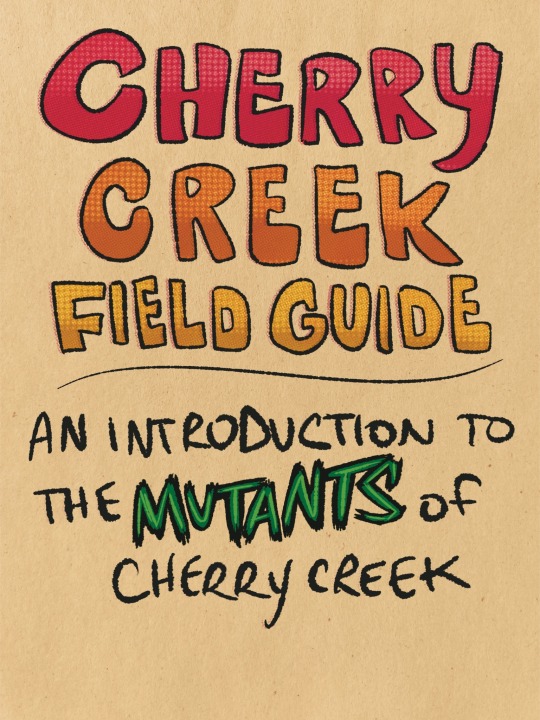

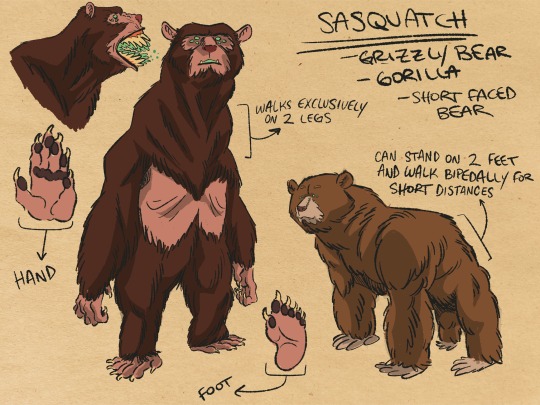
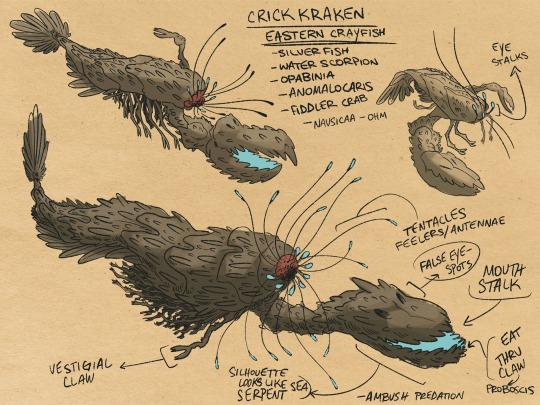
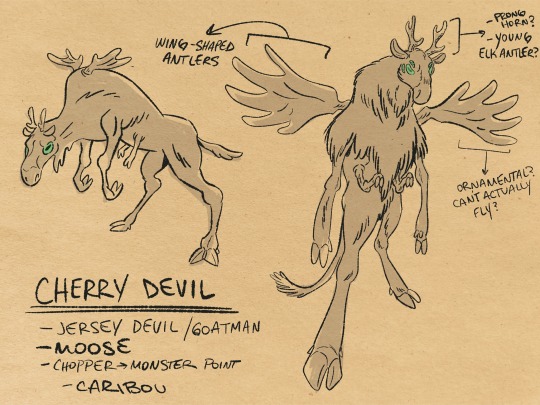
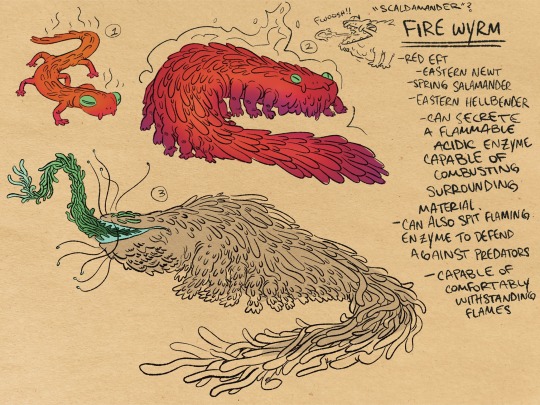
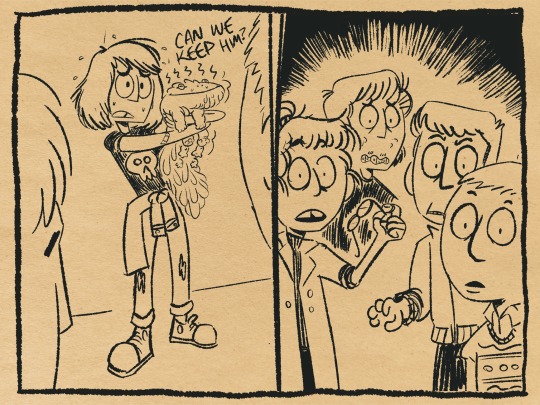
Mutants of Cherry Creek (pt 2)
Some MORE mutated critters from my YA lovecraftian horror comic set in 90s New England.
Mutagenic ooze is seeping into the town of Cherry Creek and mutating normal New England wildlife into terrifying monsters. The Cherry Creek Middle School Paranormal Investigation Club sets out to discover, catalogue, and tame all of the mutated cryptids and hopefully find the source of the toxic ooze before it permanently infects everything (and everyone) in town.
Northern Short Tailed Shrew — one of only a few venomous mammals
Brown and Black Bears - walk on two legs, climb trees, intelligent
Eastern Crayfish - present in the fossil record for at least 300 million years Eastern
Moose - huge but stealthy
Eastern Newt (Red Eft) — can secrete a strong smelling chemical from glands in its skin
At first, the animals just seem weird, strange, a little “off”. Over time, exposure to the ooze causes these creatures to get bigger, meaner, and much more dangerous. (all the beginning stage creatures shown here are newly mutated, their final stages are after only a few weeks of exposure)
I also love folklore and cryptids and I really love the idea of this club of dorky middle school cryptid hunters assigning names like “bigfoot”, “mothman”, and “hodag” to these monsters so can try and contextualize something they don’t really understand. Soon the club realizes these aren’t fun isolated critters but symptoms much larger impending ecological disaster!
I picture it like pokemon evolution, going from a cute water turtle to a kaiju which is a lot for a ten year old to handle.
Which is your favorite? What cryptid would you wanna see? What animal should I “Cryptify” next? lmk what you think!
#artists on tumblr#digital art#illustration#illustrator#character drawing#illustrated book#character concept#character illustration#fantasy art#children’s illustration#ya horror#horror for kids#lovecraft#eldritch#indie comics#fauna#bestiary#field guide#kaiju monster#monster art#creature design#character art#lovecraftian#middle grade comics#horror comics#sci fi comics#campy scifi#cryptidcore#cryptid#paranormal
39 notes
·
View notes
Text

"The auras of butterflies contain energies that can help us to connect to the Illumined angels.
Their service work is to pollinate. They may not be as efficient as bees but they glide and flutter from flower to flower, filling us with delight as we watch them. To bring joy and delight is part of their soul mission.
Butterflies go through the most extraordinary metamorphosis to transform from egg to caterpillar to cocoon and finally to emerge as glorious winged creatures. They are demonstrating to us that transformation is possible. Monarch caterpillars shed their skin four times before they become a chrysalis. They grow to over 2,700 times their original size. This is a message that huge spiritual growth is possible in our lifetimes.
And individual kinds of butterfly develop local survival mechanisms. For example, some types of night butterflies have ears on their wings so they can avoid bats!
Many insects are teaching us lessons of adaptability.
Children’s illustrations often show fairies playing with or riding on butterflies. Those painters were seeing through the veils for fairies and butterflies have a natural connection. Fairies direct butterflies and are always there to help them when they emerge from their cocoons and first spread their wings."
- The Archangel Guide to the Animal World by Diana Cooper 🦋🦋
#p#fauna#spirit guides#q#diana cooper#the archangel guide to the animal world#imaginal realms#insects#butterflies#fairycore#angelcore#naturecore#symbiosis#animals#spirit animal#sidewalkchemistry
27 notes
·
View notes
Text





The Tale of the Aiwha Pod translated from Kaminoan by Ryan Kaufman
#star wars#kaminoan culture#in universe flora and fauna#in universe legends and myths#in universe religion#in universe sources#republic commando prima guide
25 notes
·
View notes
Text
What kind of cuisines did they have on gallifrey 🤔
#leo txt#thinking abt the illustrated flora and fauna guide#and it got me thinking about food#ik they had wine but thats not exactly food hdbdbbd
5 notes
·
View notes
Text
smth i do have lying around that i still quite like is how i wanted to make up some specbio for xen flora during the period of two weeks where i really wanted to make a gravity falls journal style thing that documents xen flora and fauna (i still wanna do this! i think its still a cool idea! i just lost my motivation a while back and i want it back but my brain is too far down tf2 rn)
#brighton.txt#but i think if someone else worked on it with me or brainstormed stuff together that might actually help it get done#like guys what if a xen field guide was a real thing.... i could put it on my bookshelf....#i also think about what sort of medicinal or cooking purposes some xen flora and fauna were used for.. especially in regards to the vorts#(inspired by gary from hla cooking the headcrab. i love gary hla)#hl
5 notes
·
View notes
Text
Discovering Ecotourism Destinations in India a Journey into Nature's Embrace
#accommodations#adventures#amenities#Assam#backwaters#Bengal tiger#biodiversity#bird#bird watching#Boat Tours#coffee plantations#Coorg#cultural#destination#Destinations#Eco tourism#eco-friendly#ecosystem#Ecotourism#elephant safaris#Europe#European#European travelers#flamingos#flora and fauna#forest#greenery#guided nature#guided tours#Gujarat
0 notes
Text
#justenvironmentalscientistthings - getting distracted from writing the whump part of this fic by talking about shells lol
#dw i'll post it here & on ao3 once it's done#but like... i have relevant field guides. i HAVE to let people know about the diversity of invertebrate fauna on the atlantic coast#or else i'll Die.#chatter tag
1 note
·
View note
Text
Mljet National Park - A journey into nature's paradise
#best time to visit mljet#mljet croatia tourism#mljet cycling#mljet ferry from dubrovnik#mljet hiking trails#mljet history#mljet island activities#mljet island croatia#mljet kayaking#mljet malo jezero#mljet national park#mljet nature reserve#mljet park flora and fauna#mljet roman ruins#mljet saltwater lakes#mljet travel guide#mljet velik jezero#mljet wildlife#st mary&039;s island mljet#visit mljet
0 notes
Text
Jonathan J. Storm - Field Guide to the Southern Piedmont
BOOK REPORT: Field Guide to the Southern Piedmont by Prof. Jonathan Storm and others. A guide to help the general public identify common or distinctive organisms living in the Piedmont region of the Carolinas and Georgia.
The Listen & Be Heard Hour for Readers & Writerss2e29 Jonathan J. Storm, Briget C. Doyle, Rachel V. Furman, Julie M. Smoak & Melissa A. Storm Field Guide to the Southern Piedmont: An identification guide to over 700 common organisms in the Piedmont of the Carolinas & Georgia The Field Guide to the Southern Piedmont was created to help the general public identify common or distinctive organisms…
0 notes
Text
Pench National Park: A Complete Guide for Your Next Adventure

Pench National Park, straddling the states of Madhya Pradesh and Maharashtra in India, is a renowned wildlife sanctuary that offers a unique blend of thrilling safaris, rich biodiversity, and picturesque landscapes. Known as the inspiration for Rudyard Kipling's "The Jungle Book," Pench is a must-visit for nature enthusiasts and wildlife photographers alike. This article provides a comprehensive guide to visiting Pench National Park, covering how to get there, the best times to visit, what to expect, and tips for making the most of your trip.
Getting to Pench National Park
By Air: The nearest airport to Pench National Park is Dr. Babasaheb Ambedkar International Airport in Nagpur, approximately 93 kilometers away. From Nagpur, you can hire a taxi or take a bus to the park. The airport is well-connected with major cities across India, making it a convenient entry point for travelers.
By Train: Nagpur Railway Station is the nearest major railway station, around 90 kilometers from Pench. Trains from various parts of India connect to Nagpur. Alternatively, Jabalpur Railway Station is another option, though it is further away at about 200 kilometers. From either station, taxis and buses are available to take you to the park.
By Road: Pench is well-connected by road and can be accessed via private vehicle or bus. The drive from Nagpur to Pench takes about 2-3 hours. Regular bus services also operate from Nagpur and Jabalpur to Pench.
Best Time to Visit
Pench National Park is open to visitors from October to June. The best time to visit largely depends on what you hope to experience:
Winter (October to February): This is the most comfortable time to visit due to the pleasant weather. It's also the best time for bird watching as migratory birds flock to the park.
Summer (March to June): While the temperatures can soar, summer is the best time for wildlife sightings, especially tigers, as animals gather around water sources.
Monsoon (July to September): The park is closed during this period due to heavy rains, which make the terrain difficult to navigate.

Safari Experience
Pench National Park offers several safari options that provide an immersive experience into the heart of the jungle:
Jeep Safari: The most popular way to explore the park, jeep safaris, are conducted twice daily – in the morning and afternoon. Morning safaris are usually from 6:30 AM to 11:00 AM, while afternoon safaris run from 3:00 PM to 6:00 PM in winter and 4:00 PM to 7:00 PM in summer (TheTopTours) (Couple of Journeys). It’s advisable to book your safari in advance through the official Madhya Pradesh tourism website to secure your spot.
Night Safari: A unique offering, night safaris provide a chance to experience the park's nocturnal wildlife. These safaris are typically conducted in the buffer zones and offer sightings of creatures like the Indian wolf and various nocturnal birds (TheTopTours).
Walking Safari: For those who prefer a more intimate experience, guided walking safaris are available. These walks allow visitors to explore the park on foot and learn about the diverse flora and fauna up close (Global Parks).
Flora and Fauna
Pench National Park is home to a rich diversity of wildlife. The park's terrain is dominated by teak forests, interspersed with other tree species like Saja, Bija, and Lendia. The undergrowth is thick with grasses and shrubs, providing ample cover for the park's inhabitants.
Fauna: The park is famous for its population of Royal Bengal tigers. Other predators include leopards, wild dogs (dhole), wolves, hyenas, and jackals. Herbivores such as gaur (Indian bison), sambar deer, chital (spotted deer), and wild boar are also commonly seen. The park is also a bird watcher’s paradise with over 210 species of birds, including the Malabar pied hornbill, Indian pitta, and various species of owls and eagles (A Soul Window) (TheTopTours).
Flora: The lush vegetation of Pench includes a variety of trees, shrubs, and grasses. Key tree species include teak, Indian laurel, and mahua, which provide a scenic backdrop and essential habitat for the park’s wildlife(Global Parks).
Accommodation Options
Pench offers a range of accommodation options to suit different budgets and preferences:
Luxury Resorts: For a luxurious stay, resorts like the Village Machaan offer upscale amenities, guided tours, and a comfortable stay amidst nature.
Mid-Range Hotels: Options like Village Machaan and Tathastu Resorts provide comfortable lodging with good facilities at moderate prices.
Budget Stays: For budget travelers, there are several guest houses and eco-camps that offer basic amenities and a closer connection to nature (Couple of Journeys).
Tips for Visitors
Book in Advance: Whether it’s your safari or accommodation, booking well in advance is crucial, especially during peak seasons.
Carry Valid ID: Make sure to carry a valid ID proof matching the details provided during safari booking. This is mandatory for entry.
Dress Appropriately: Wear neutral-colored clothing to blend with the environment and avoid bright colors. Also, carry hats, sunglasses, and sunscreen for protection against the sun.
Follow Park Rules: Adhere to all park regulations, including staying inside the vehicle during safaris and maintaining silence to avoid disturbing the wildlife.
Pack Essentials: Carry water, snacks, and a good camera with a zoom lens to capture the wildlife and scenic beauty.
Conclusion
Pench National Park offers an unparalleled experience for wildlife enthusiasts and nature lovers. Its rich biodiversity, thrilling safari options, and the serene beauty of its landscapes make it a top destination for anyone looking to explore the wild. By planning your trip well in advance and following the tips provided, you can ensure a memorable and enriching visit to this enchanting park.
For more information and bookings, visit the Nature's Sprout and official Madhya Pradesh Forest Department website (Couple of Journeys).
#Pench National Park safari booking#Pench National Park travel guide#Pench National Park flora and fauna#Pench National Park entry gates#Pench National Park safari timings#Accommodation in Pench National Park#Pench National Park tiger sightings#Best time to visit Pench National Park
0 notes
Text
One of my next Clanmew expansions is going to HAVE to be snakes because girl help everyone draws Honeyfern and Frecklewish being poisoned by pythons and it makes me want to pop a wheelie.
#Since some clanmew expansion packs are basically doubling as clan culture guides to fauna/flora#And how the clan cats percieve them#Plus education about british ecology wrapped up in silly battle cats like a pill in a slice of cheese#A python is SNOOT and a PUPPY#An adder looks like an ANGRY BOY
150 notes
·
View notes
Text
Shoutout to everyone with a fuck ton of hobbies trying to pack for a plane.
Sitting here feeling sad because I can't take all of my hobbies as well as clothes/toiletries.
WHAT DO U MEAN MY LIFE HAS TO FIT INTO A CARRY ON???
#for context I'm going back to my childhood home for a little over a month#All of my items!!!#I am a maximalist#literally left my bf a 10 minutes voice note being upset that I can't take everything#am I gonna use all of it?#no.#but I want the option tooooo#I know my other nerdy ppl will get this#I CAN'T EVEN TAKE MY FAUNA/FLORA IDENTIFICATION GUIDES#UGH#my life is so hard /j#I am a dragon who must be surrounded by all of my treasures 24/7 or I get upset#Also I have nothing in my childhood home bc I took it all with me to uni (legit on a diff island)#only taking 2 sets of dice for me and my bf#i might perish#I CAN'T EVEN TAKE MY STUFFED ANIMALS#THIS IS A CRIME#:C#I will survive#but I will not be happy abt it
0 notes
Text

from the 'animal companions {soul buddies/spirit guides}' Pinterest board
An often neglected self-healing tool is found within the Animal Kingdom. Just like our human relationships, non-human animals can help us to blossom into our highest potential. Remain aware of how animals show up in your life, deepen into your natural role as a steward of the earth, and watch your life unfold in new ways.
#txt#self healing#fauna#holistic leveling up#animal companions#spirit animal#totem animal#spirit guides#spiritual growth#that girl#leveling up#green juice girl#glow up#slow living#soft living#mindfulness#animal liberation#veganism#earth stewardship#symbiosis#mutualism#soul growth#interdependence#right relationship#synchronicity#sidewalkchemistry
10 notes
·
View notes
Text
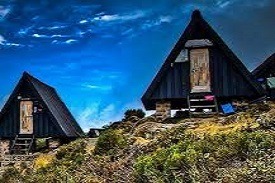
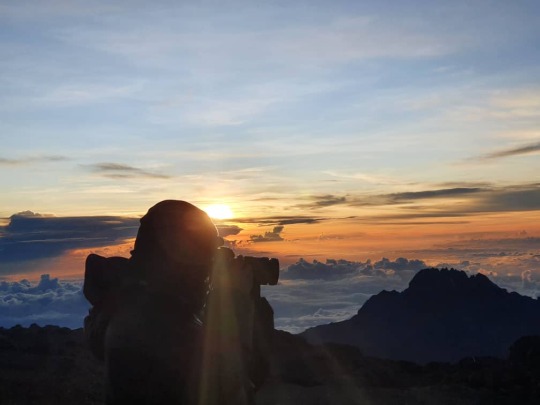
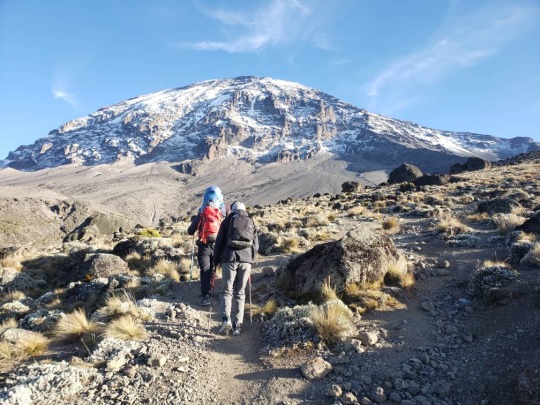
The Marangu route, also known as the "Coca-Cola" route, is the oldest, most well-established route on Kilimanjaro. This is the only route which offers sleeping huts in dormitory style accommodations in lieu of camping. There are 60 bunk beds each at Mandara and Kibo Huts, and 120 bunk beds at Horombo Hut. Guests are supplied with mattresses and pillows, but sleeping bags are still required. The huts have communal dining halls and basic washrooms, ranging from flushing toilets and running water at the lower huts to long drop toilets and buckets of water at Kibo Hut. Many favor Marangu because it is considered to be the easiest path on the mountain, given its gradual slope and direct path. However, the short time frame of the route makes Altitude Acclimatization fairly difficult. The route approaches Mount Kilimanjaro from the southeast. Marangu is unfortunately less scenic than the other routes because the ascent and descent are along the same path. It is also the most crowded route for that reason.
Day 1: Marangu Gate to Mandara Hut Elevation (ft): 6,046 ft to 8,858 ft Distance: 8 km Hiking Time: 4-5 hours Habitat: Rain Forest Hut: Mandara Hut. We head to the Marangu Gate for the necessary formalities before beginning our trek. The trail climbs through a tropical rain forest near the upper edge of the forest line, where we sometimes see playful blue monkeys. The trail then widens to expose beautiful hillsides until we reach Mandara Hut.
Day 2: Mandara Hut to Horombo Hut Elevation (ft): 8,858 ft to 12,205 ft Distance: 12 km Hiking Time: 6-8 hours Habitat: Heath / Moorland Our second day on the trail starts up with a steep ascent through the forest and opens into high moorland. If the sky is clear, we might get our first views of Kibo and Mawenzi Peaks. Those two volcanic peaks make up the summit of Kilimanjaro.
Day 3: Horombo Hut to Mawenzi Hut to Horombo Hut Elevation (ft): 12,205 ft to 14,160 ft to 12,205 ft Distance: 10 km Hiking Time: 3-5 hours Habitat: Heath This extra day is used for Adaptation. We hike towards or all the way to Mawenzi Hut and back. The unique landscape offers motivating views of Kibo and Mawenzi.
Day 4: Horombo Hut to Kibo Hut Elevation (ft): 12,205 ft to 15,430 ft Distance: 10 km Hiking Time: 6-8 hours Habitat: Alpine Desert On this day we climb gently, then cross the lunar desert of the “Saddle” between Mawenzi and Kibo to reach our campsite, which sits at the bottom of the Kibo crater wall. Once at Camp, we rest and enjoying an early dinner and prepare for summit day.
Day 5: Kibo Hut to Uhuru Point to Horombo Hut Elevation (ft): 15,430 ft to 19,341 ft to 12,205 ft Distance: 22 km Hiking Time: 10-13 hours Habitat: Arctic We wake up in the middle of the night and begin the final push to reach the Roof of Africa. The trail to Gilman’s Point is very steep, and the ascent will be slow and steady. From Gilman’s, it is a traverse along the crater rim to Uhuru Peak. We stay at the summit for a short time, to take photos and enjoy the views, before retracing our steps all the way back to Horombo Hut.
Day 6: Horombo Hut to Marangu Gate Elevation (ft): 12,205 ft to 6,046 ft Distance: 20 km Hiking Time: 5-7 hours Habitat: Rain Forest A long trek is in store for today, however it is mostly downhill. Once we reach the park headquarters, there at Marangu Gate, we pick up our certificate, that proves our achievement, and catch our vehicle transfer to the Hotel in Moshi.
Included o Park fees, o Hut fees o Rescue fees o 18% VAT on tour fees & services, which cost nearly 55 % of the total cost charged. o Transportation to & from the Mountain Gate o Professional mountain guides, cooks and porters o 3 meals daily while on the mountain
Not Included o Both national and international flights o Medical Insurance o Tips to Mountain Crew o Items of a personal nature o Laundry Services o Alcoholic beverages
Contact Us via WhatApp +255 786499087
Email us Direct: [email protected]
#Marangu Route 6 days Trek#Kilimanjaro Marangu Itinerary#Marangu Route Summit Climb#6-day Marangu Route Highlights#Kilimanjaro Marangu Huts#Marangu Route Acclimatization#Best Time to Hike Marangu#Marangu Route Camping Options#Kilimanjaro Scenic Views#Marangu Route Difficulty Level#Kilimanjaro National Park#Marangu Route Accommodation#Kilimanjaro Guided Expeditions#Marangu Route Altitude Sickness#Kilimanjaro Weather Conditions#Marangu Route Trekking Adventure#Kilimanjaro Uhuru Peak Ascent#Marangu Route Flora and Fauna#Kilimanjaro Cultural Tours
0 notes
Text
Discover the Unseen: Your Ultimate Hiking Guide to Mount Desert Island, Maine
Welcome to an exciting journey through the untouched wilderness of Mount Desert Island, Maine, your next hiking destination. This guide is your ticket to navigating the picturesque landscapes, from the rugged coastline to the majestic peaks. Get ready to encounter the island’s unique flora and fauna, immerse yourself in the serene beauty of its vast forests, and conquer its challenging trails.…

View On WordPress
#beginner hiking guide#flora and fauna#hiking adventure#hiking guide#hiking in Maine#hiking trails#island hiking#Maine hiking#Maine outdoor#majestic peaks#Mount Desert Island#Mount Desert Island trekking#Mount Desert wildlife#natural landscapes#outdoor adventure#rugged coastline#seasoned hiker destinations#serene forests#travel Maine#unique hiking experience#wilderness exploration
0 notes